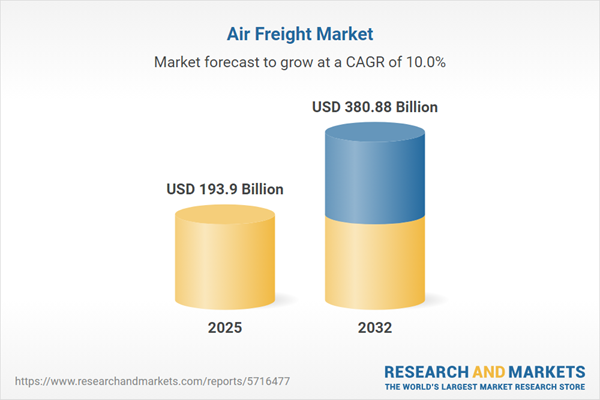Speak directly to the analyst to clarify any post sales queries you may have.
The global air freight market is navigating an era of rapid transformation, as industry leaders adapt to technological progress, new regulations, and evolving logistics needs. Decision-makers are challenged to rethink legacy frameworks and align their strategies for long-term growth in this dynamic landscape.
Market Snapshot: Air Freight Market Size, Growth, and Projections
The air freight market grew from USD 177.17 billion in 2024 to USD 193.90 billion in 2025. It is expected to continue growing at a CAGR of 10.03%, reaching USD 380.88 billion by 2032. These growth metrics reflect the sector’s critical role in meeting increasing demand for high-value and time-sensitive cargo. Factors such as digitalization, trade policy adjustments, and heightened sustainability focus are at the core of this expansion. Senior leaders must pay close attention to ongoing market volatility and geographic divergences to capture maximum opportunity.
Scope & Segmentation: Comprehensive Coverage Across Markets
This analysis offers deep insights into industry structure, operational segmentation, and evolving demand drivers. The market is segmented as follows:
- Service Types: Chartered cargo services, consolidated air freight, door-to-door solutions, express delivery, and standard freight options.
- Cargo Categories: General cargo, special cargo comprising dangerous goods, live animals, perishables, pharmaceuticals and healthcare products, and valuable cargo.
- Industry Verticals: Aerospace and defense, automotive, chemicals, e-commerce, electronics, food and beverages, pharmaceuticals, retail, textiles, and apparel.
- Service Durations: Long haul and short haul operations.
- Destination Markets: Domestic lanes and international routes.
- Regional Focus: Americas (North America, Latin America), Europe Middle East & Africa (with detailed subregions), and Asia-Pacific (including core trade and growth hubs).
- Companies Analyzed: Air Canada Cargo, Arc Worldwide Limited, C&D Logistics Ltd., Canaan Group, Cargojet, Cargolux Airlines International S.A., CMA CGM Group, Couriers and Freight International, DB SCHENKER by DSV, Delmar International Inc., Deutsche Post AG, DSV Group, Emirates Group, Expeditors International of Washington, Inc., FedEx Corporation, Hellmann Worldwide Logistics SE & Co. KG, Korean Air Co., Ltd., Lufthansa Cargo AG, Nippon Express Co., Ltd., Ocean-Air Freight LTD., Qatar Airways Group, Sealion Cargo Inc., Singapore Airlines Ltd., UKR Shipping LLC, United Parcel Service, Inc., and YUSEN LOGISTICS CO., LTD.
Key Takeaways for Senior Decision-Makers
- Technological innovation, including the integration of IoT sensors and advanced analytics, is raising operational visibility and driving more proactive cargo management.
- Sustainability is influencing fleet modernization and route design as stakeholders seek greener, more efficient solutions through alternative fuels and collaborative green corridors.
- Shifting global trade patterns, often in response to evolving tariffs and regulation, require a flexible and adaptive approach to network planning and carrier alliances.
- Segmented services, especially within express and specialized cargo, present new pathways to growth for carriers able to tailor offerings to emerging needs.
- Regional divergence is sharpening, with e-commerce-driven express demand buoying growth in the Americas, infrastructure development catalyzing Europe, Middle East & Africa, and manufacturing expansion sustaining Asia-Pacific’s leadership.
- Resilience relies on rapid response to regulatory shifts, supply chain disruptions, and the ability to leverage real-time data for network realignment.
Impact of United States Tariffs on Global Air Cargo
Recent tariffs imposed by the United States have driven significant adjustments in supply chains. Shippers have diversified origin points and shifted flows to alternative hubs to manage increased costs and protect service quality. Air carriers have optimized fleet deployment and adapted pricing models, resulting in heightened activity at secondary airports and more dynamic contract structures. These strategies showcase the market's ability to absorb shocks while maintaining continuity in global supply chains.
Methodology & Data Sources
This report combines primary data—executive interviews with key carriers, forwarders, and agencies—with secondary research from industry publications, proprietary datasets, and open-source intelligence. Data triangulation and expert validation ensure the findings are grounded, comprehensive, and actionable.
Why This Report Matters
- Enables senior executives to benchmark strategy against global trends and regulatory risks in the air freight market.
- Supports informed investment in technology, sustainability, and network realignment by offering granular segmentation and robust regional insights.
- Facilitates proactive response to tariff impacts, capacity shifts, and evolving demand, helping leaders future-proof operations and stay competitive.
Conclusion
This report empowers decision-makers to navigate the evolving air freight sector by highlighting actionable strategies and the importance of adaptability. Leaders can leverage these insights to drive operational excellence and sustainable market advantage.
Additional Product Information:
- Purchase of this report includes 1 year online access with quarterly updates.
- This report can be updated on request. Please contact our Customer Experience team using the Ask a Question widget on our website.
Table of Contents
3. Executive Summary
4. Market Overview
7. Cumulative Impact of Artificial Intelligence 2025
Companies Mentioned
The companies profiled in this Air Freight market report include:- Air Canada Cargo
- Arc Worldwide Limited
- C&D Logistics Ltd.
- Canaan Group
- Cargojet
- Cargolux Airlines International S.A.
- CMA CGM Group
- Couriers and Freight International
- DB SCHENKER by DSV
- Delmar International Inc.
- Deutsche Post AG
- DSV Group
- Emirates Group
- Expeditors International of Washington, Inc.
- FedEx Corporation
- Hellmann Worldwide Logistics SE & Co. KG
- Korean Air Co., Ltd.
- Lufthansa Cargo AG
- Nippon Express Co., Ltd.
- Ocean-Air Freight LTD.
- Qatar Airways Group
- Sealion Cargo Inc.
- Singapore Airlines Ltd.
- UKR Shipping LLC
- United Parcel Service, Inc.
- YUSEN LOGISTICS CO., LTD.
Table Information
| Report Attribute | Details |
|---|---|
| No. of Pages | 194 |
| Published | November 2025 |
| Forecast Period | 2025 - 2032 |
| Estimated Market Value ( USD | $ 193.9 Billion |
| Forecasted Market Value ( USD | $ 380.88 Billion |
| Compound Annual Growth Rate | 10.0% |
| Regions Covered | Global |
| No. of Companies Mentioned | 27 |









